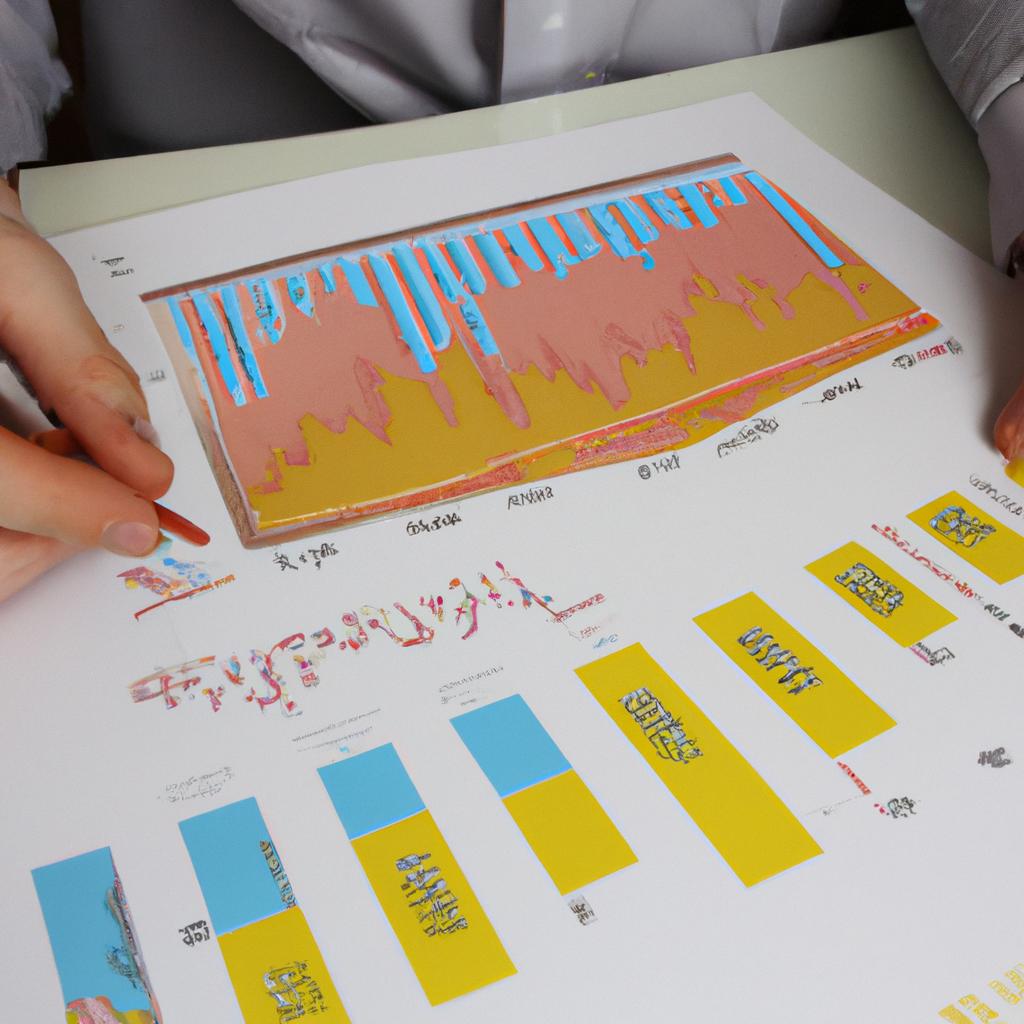Discounted Cash Flow (DCF) Method: Business Appraisal and Services Valuation Methods

The Discounted Cash Flow (DCF) method is a widely used approach for evaluating the financial value of businesses and services. This method involves forecasting future cash flows and discounting them to their present values in order to determine the intrinsic worth of an investment. By taking into account the time value of money, the DCF method provides a rigorous framework for assessing business profitability and making informed investment decisions.
For instance, let us consider a hypothetical case study involving a technology startup seeking funding from potential investors. Using the DCF method, the company’s management can estimate its future cash flows based on projected sales growth and operational expenses. These cash flows are then discounted back to their present values using an appropriate discount rate that reflects the risk associated with investing in the start-up. The resulting net present value indicates whether or not the venture is financially viable and attractive to investors.
In addition to its application in investment decision-making, the DCF method also plays a crucial role in business appraisal and valuation services. Whether it is determining fair market values for mergers and acquisitions or assessing the worth of intangible assets such as patents and trademarks, this valuation technique enables professionals to provide accurate estimates that align with industry standards. Through careful analysis of historical financial data, consideration of market conditions, consideration of market conditions, and evaluation of the company’s competitive advantage, the DCF method allows for a comprehensive and objective assessment of a business’s value.
Furthermore, the DCF method can be used to compare different investment opportunities and prioritize them based on their potential returns. By calculating the net present value of each investment option, decision-makers can make informed choices that maximize shareholder value and allocate resources efficiently.
It is important to note that while the DCF method provides valuable insights into a company’s financial performance and potential profitability, it relies heavily on accurate forecasting and assumptions. Factors such as market volatility, changes in regulatory environment, and unexpected events can significantly impact actual cash flows compared to projected ones. Therefore, it is crucial to regularly review and update projections to ensure the reliability of DCF-based valuations.
Ultimately, the Discounted Cash Flow method offers a systematic approach for assessing the financial worth of businesses and services. Its ability to account for both timing and risk makes it a powerful tool in making investment decisions and conducting thorough business appraisals.
Definition of DCF method
Definition of DCF Method
The Discounted Cash Flow (DCF) method is a widely used financial valuation technique employed to determine the intrinsic value of an investment or business. By estimating the present value of future cash flows, this approach takes into consideration the time value of money and aims to reflect the true worth of an asset. To illustrate its application, consider a hypothetical case study where Company XYZ plans to invest in a new manufacturing facility.
To begin with, understanding the principles underlying the DCF method is essential. The fundamental assumption is that cash received in the future holds less value than immediate cash due to factors such as inflation, risk, and opportunity cost. Therefore, by discounting projected future cash flows back to their present value at an appropriate rate, investors can ascertain whether an investment will generate positive net present value (NPV).
To better grasp how DCF works and why it has gained prominence among financial analysts and investors alike, let us explore a few key aspects:
- Time Value of Money: The concept that money available today is more valuable than the same amount in the future given potential risks and opportunities for alternative investments.
- Discount Rate: Also known as required rate of return or hurdle rate; it represents the minimum acceptable annual percentage return an investor would demand considering various factors like risk level and market conditions.
- Cash Flows Projection: Estimating future cash inflows and outflows generated by an investment over its expected life span.
- Present Value Calculation: Determining the current worth of projected cash flows by applying appropriate discount rates.
In conclusion, the DCF method provides a systematic framework for evaluating investments based on their ability to generate sufficient returns relative to their associated risks. In subsequent sections, we will delve further into calculating future cash flows without overlooking crucial considerations such as growth projections and determining suitable discount rates.
Note: Proceeding with “Calculating Future Cash Flows” section, we will now explore the process of projecting cash inflows and outflows generated by an investment.
Calculating the future cash flows
DCF Method: Calculating the Future Cash Flows
In order to effectively utilize the Discounted Cash Flow (DCF) method for business appraisal and services valuation, it is crucial to accurately calculate the future cash flows. This section will discuss the process of determining these future cash flows and its importance in conducting a comprehensive analysis.
One example that illustrates the significance of calculating future cash flows involves a hypothetical scenario where an investor is considering acquiring a restaurant chain. To determine the potential profitability of this investment, the investor must estimate the expected cash flow generated by each individual restaurant over a defined period of time. By analyzing historical data, market trends, and industry forecasts, they can project revenue streams and identify any potential risks or uncertainties that may impact future earnings.
When calculating future cash flows using DCF methodology, several key factors should be considered:
- Revenue Projections: Forecasting sales figures based on market conditions, customer demand, pricing strategies, and competitive dynamics.
- Cost Estimation: Determining anticipated expenses such as labor costs, raw materials, rent/utilities, marketing expenditures, and other operating expenses.
- Capital Expenditures: Assessing investments required for equipment upgrades, renovations, technological advancements or expansions necessary for business growth.
- Working Capital Changes: Considering fluctuations in inventory levels, accounts receivable/payable cycles, and cash reserves needed to support day-to-day operations.
To better understand how these factors interrelate when projecting future cash flows within DCF analysis framework; consider Table 1 below:
| Factor | Year 1 | Year 2 | Year 3 |
|---|---|---|---|
| Revenue Projection | $500k | $600k | $700k |
| Total Operating Expenses | $400k | $450k | $500k |
| Capital Expenditure | -$50k | -$20k | -$30k |
| Working Capital Changes | $10k | -$5k | $15k |
| Free Cash Flow (FCF) Calculation | $60k | $75k | $85k |
Table 1: Example of Future Cash Flows Projection
As shown in the table above, calculating future cash flows requires a thorough analysis of revenue projections, operating expenses, capital expenditures, and working capital changes. By estimating these factors accurately and projecting them over a defined time period, investors can determine the potential profitability and value of an investment opportunity using DCF methodology.
Moving forward, the subsequent section will delve into another crucial aspect of utilizing the DCF method for business appraisal and services valuation – determining the discount rate. Understanding how to establish an appropriate discount rate is essential as it impacts the present value calculation used within the DCF framework.
Determining the discount rate
Calculating the future cash flows is a crucial step in the Discounted Cash Flow (DCF) method for business appraisal and services valuation. By estimating the expected cash inflows and outflows over a specified time period, analysts can determine the intrinsic value of a company or service. To illustrate this process, let’s consider a hypothetical case study of a tech startup that is projecting its cash flows for the next five years.
In order to calculate future cash flows, analysts need to consider various factors such as revenue growth, operating expenses, taxes, and capital expenditures. Let’s assume our tech startup expects its revenues to grow by 20% annually for the next five years. After deducting operating expenses and taxes, it estimates free cash flow of $1 million in Year 1, which is projected to increase by 10% each year thereafter.
To provide clarity on how these calculations are done within the DCF method, here are four key considerations:
- Revenue growth: Analysts must forecast the expected growth rate of revenue based on market conditions and industry trends.
- Operating expenses: It is important to accurately estimate all costs associated with running the business including salaries, marketing expenses, rent, etc.
- Taxes: Appropriate tax rates should be applied to calculate after-tax cash flows.
- Capital expenditures: Any anticipated investments in assets or equipment should be accounted for in order to derive accurate future cash flows.
Taking into account these aspects allows us to project an estimated stream of future cash flows. These projections become essential inputs when determining the discount rate used in valuing these cash flows.
Now that we have established how to calculate future cash flows effectively under DCF analysis, we can move on to discussing the determination of the discount rate. This factor plays a significant role in assessing risk and evaluating investment opportunities within this methodology.
Discounting the cash flows
Determining the Discount Rate and Discounting Cash Flows
In determining the discount rate for a discounted cash flow (DCF) analysis, various factors need to be considered. These include the risk associated with the investment, expected return on other comparable investments, and prevailing interest rates in the market. For example, let’s consider a hypothetical case where Company A is evaluating an investment opportunity in a new product line. The company estimates that the project will generate annual cash flows of $500,000 over a period of five years. To determine the appropriate discount rate, Company A considers factors such as the industry’s risk profile, current market conditions, and its own cost of capital.
To guide decision-making in selecting an appropriate discount rate, it is important to understand some key concepts:
- Risk premium: This represents additional returns investors expect for taking on higher-risk investments.
- Beta coefficient: It measures how volatile an investment is compared to the overall market.
- Weighted average cost of capital (WACC): This takes into account both debt and equity financing costs based on their respective proportions in a firm’s capital structure.
- Market risk-free rate: This refers to the theoretical return investors can earn by investing in assets with no default or inflation risk.
These considerations collectively help determine an appropriate discount rate for calculating present values of future cash flows. By incorporating these factors into the valuation process, analysts are able to make more informed decisions about potential investments.
| Factor | Explanation |
|---|---|
| Risk Premium | Additional returns required by investors due to increased risk associated with an investment |
| Beta Coefficient | Measures volatility of an investment relative to the broader market |
| Weighted Average Cost of Capital (WACC) | Considers both debt and equity financing costs based on their respective proportions in a firm’s capital structure |
| Market Risk-Free Rate | Theoretical return investors can earn by investing in assets with no default or inflation risk |
By carefully considering these factors, analysts can determine an appropriate discount rate that reflects the investment’s level of risk.
Transitioning into the subsequent section on Terminal Value Calculation:
Having established the discount rate and its importance in valuing a business, it is now crucial to understand another critical aspect of the DCF method: calculating the terminal value. This calculation accounts for cash flows beyond the explicit forecast period and plays a pivotal role in determining a business’s overall value.
Terminal value calculation
Discounted Cash Flow (DCF) Method: Business Appraisal and Services Valuation Methods
Section Transition: Building upon the concept of discounting cash flows, we now explore the calculation of terminal value. To illustrate this further, let us consider a hypothetical case study involving a technology company.
Terminal Value Calculation
In order to determine the terminal value of a business or service, analysts employ various approaches such as the perpetuity growth method or multiple-based methods. One common approach is the Gordon Growth Model, which assumes that cash flows will grow at a constant rate indefinitely. This model can be used when projecting long-term performance beyond explicit forecast periods.
To better understand how terminal value is calculated using the DCF method, consider our hypothetical technology company. Let’s assume that after five years of projected cash flows, it is expected to generate an annual free cash flow of $10 million in perpetuity with a constant growth rate of 3%. Applying the formula for calculating perpetual growth:
[ \text{Terminal Value} = \frac{\text{FCF}_n(1+g)}{(r-g)}, ]
where FCF_n represents free cash flow in year n, g represents the growth rate, and r denotes the discount rate. In our example, assuming a discount rate of 10%, we can calculate the terminal value as follows:
[ \text{Terminal Value} = \frac{$10\text{M}(1+0.03)}{(0.10-0.03)} = $157.\overline{14}\text{M}. ]
This demonstrates how terminal value can significantly impact overall valuation results and highlights its importance within the DCF framework.
To underscore key considerations related to discounted cash flow analysis and its implications for business appraisal and services valuation, here are some notable points:
- The choice of appropriate discount rates in valuing future cash flows plays a critical role in determining present values.
- Accurate cash flow projections are essential for reliable valuations, requiring a thorough understanding of the business and its industry dynamics.
- Sensitivity analysis should be conducted to assess how changes in key assumptions impact valuation outcomes.
Table: Key Considerations in Discounted Cash Flow Analysis
| Factors | Implications |
|---|---|
| Discount rate selection | Influences present value determination and sensitivity of valuations. |
| Cash flow accuracy | Directly affects reliability and precision of valuation results. |
| Industry dynamics | Understanding market trends and competitive landscape enhances projection accuracy. |
| Assumption sensitivity | Evaluating varying scenarios helps gauge potential range of valuation outcomes. |
These considerations underscore the complexity involved in conducting DCF analyses, highlighting the need for meticulous attention to detail and comprehensive financial modeling techniques.
Transition into subsequent section – Interpreting the DCF result:
Having explored the calculation of terminal value within the DCF framework, we will now delve into interpreting the result obtained through this method.
Interpreting the DCF result
Terminal Value Calculation
Having discussed the discounted cash flow (DCF) method and its importance in business appraisal and services valuation, we will now delve into the calculation of terminal value. This section aims to provide a comprehensive understanding of how terminal value is determined within the DCF framework.
To illustrate this concept, let’s consider a hypothetical case study: Company XYZ, a technology startup that has been operating for five years. In order to determine the company’s intrinsic value using the DCF approach, it is crucial to estimate the future cash flows beyond the explicit forecast period. This is where terminal value comes into play.
The calculation of terminal value involves two key components: estimating the perpetual growth rate and determining an appropriate exit multiple. The perpetual growth rate represents the assumed constant growth rate at which cash flows will continue indefinitely after the explicit forecast period. On the other hand, the exit multiple reflects the market’s perception of a company’s long-term prospects by valuing it relative to certain financial metrics such as earnings or revenue multiples.
In order to calculate terminal value accurately, several factors need to be considered:
- Selection of an appropriate discount rate: The choice of discount rate plays a significant role in determining present values and ultimately affects how terminal value is calculated.
- Sensitivity analysis: Conducting sensitivity analysis allows for an assessment of how changes in assumptions regarding growth rates or discount rates impact overall valuations.
- Market conditions and industry trends: Understanding prevailing market conditions and industry-specific dynamics helps in making informed estimates about future performance.
- Company-specific considerations: Tailoring calculations based on company-specific factors like competitive advantage, technological advancements, or regulatory environment can enhance accuracy in determining terminal value.
Table 1 below provides an overview of different methods used to calculate terminal value within DCF analysis:
| Method | Description |
|---|---|
| Perpetuity Growth Method | Assumes a constant growth rate perpetually beyond explicit forecasts |
| Exit Multiple Method | Considers a multiple of relevant financial metrics to estimate terminal value |
| Earnings-based Method | Based on the company’s projected earnings beyond the forecast period |
| Comparable Company Analysis | Utilizes valuation multiples derived from similar companies in the industry |
In summary, the calculation of terminal value is a crucial step in the DCF method. It allows for estimation of future cash flows beyond explicit forecasts and contributes significantly to determining a company’s intrinsic value. By considering factors such as discount rates, market conditions, and company-specific considerations, analysts can arrive at more accurate valuations that aid decision-making processes.
Table 1: Methods for Calculating Terminal Value
By incorporating these various techniques, an analyst can derive meaningful insights into a business’s long-term potential. Understanding how terminal value is calculated within the DCF framework is essential in accurately valuing a company and making informed investment decisions.






